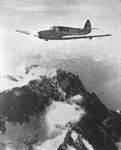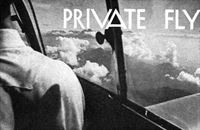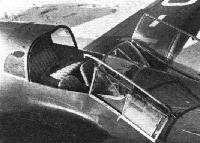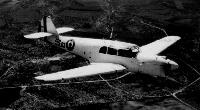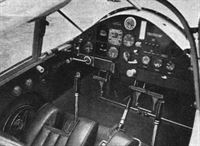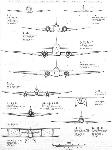
Варианты
- Messerschmitt - Bf.108 Taifun - 1934 - Германия
- Nord - Nord 1101 Noralpha - 1943 - Франция
- Nord - Nord 1200 Norecrin / Nord 1220 Norelan - 1945 - Франция
Messerschmitt Bf 108 Taifun и Me 208
Накануне Второй мировой войны M.35 конструкции Вилли Мессершмитта зарекомендовал себя как один из лучших пилотажных самолетов мира. M.35 стал основой для создания революционного M.37, более известного как Bf 108 Taifun. История Taifun восходит к 4-м соревнованиям "Challenge deTourisme Internationale", проходившим в 1 934 году. Для них в соответствии с контрактом построили шесть самолетов. Испытания прототипа начались весной 1934 года. Самолет был низкопланом, с крылом консольного типа, закрытой кабиной и убираемым шасси и оснащался мотором Hirth HM 8U в 250 л.с. Машина также летала с мотором Argus As 17 в 220 л.с. Серийный Bf 108A на соревнованиях выступил неудачно, уступив более легким, хотя и менее совершенным, машинам. Однако высокие летные данные Bf 108A позволили установить на нем в конце 1930-х годов несколько рекордов и победить в ряде воздушных гонок. Люфтваффе выбрали Bf 108A в качестве связного самолета и буксировщика мишеней. Bf 108A экспортировался в Болгарию, Венгрию, Японию, Румынию, СССР, Швейцарию и Югославию. Накануне Второй мировой войны посольство Германии в Лондоне "зондировало почву" на предмет поставок Bf 108A британским ВВС. Два Taifun с британской гражданской регистрацией получили местное наименование Aldon. Несколько трофейных машин использовали в Королевских ВВС после окончания войны. В Германии самолет серийно строился до 1942 года, затем производство перенесли на завод "SNCAN" под Парижем. Всего до конца войны было выпущено 885 самолетов. Компания "SNCAN (Nord)" продолжила совершенствовать конструкцию и после, построив в общей сложности 285 машин Bf 108 и Me 208. Несколько самолетов германской и французской сборки в настоящее время находятся в летном состоянии.
Варианты
Bf 108B: основной серийный вариант с хвостовой колесной опорой шасси вместо костыля и мотором Argus As 10C мощностью 270 л.с.
Bf 108C: проект скоростного варианта самолета с мотором Hirth HM 512 мощностью 400 л.с.; не строился
Me 208: улучшенный вариант с убираемым шасси с носовой опорой; два прототипа построены в годы войны французской "SNCAN", один из которых разбился
ТАКТИКО-ТЕХНИЧЕСКИЕ ХАРАКТЕРИСТИКИ
Messerschmitt Bf 108B Taifun
Тип: четырехместный моноплан с закрытой кабиной
Силовая установка: один мотор Argus As 10C мощностью 240 л. с.
Летные характеристики: максимальная скорость 300 км/ч; практический потолок 5000 м; максимальная дальность 1000 км
Масса: пустого 880 кг; максимальная взлетная 1385 кг
Размеры: размах крыла 10,50 м; длина 8,30 м; высота 2,30 м; площадь крыла 16,40 м2
Описание:
- Messerschmitt Bf 108 Taifun и Me 208
- Nord 1000 Pingouin и 1100 Noralpha
- Flight, November 1934
THE FOURTEENTH PARIS AERO SHOW - Flight, April 1937
AN ANGLICISED NEWCOMER - Flight, June 1939
SOMETHING EXCEPTIONAL
Фотографии
-
Aeroplane Monthly 1983-02
Регистрационный номер: G-ATBG Lindsay Walton's Nord 1002 Pingouin G-ATBG, photographed by RICHARD WILSON. The aircraft was previously registered in France as F-BGVX, F-OTAN-5 and F-BGVX again, before appearing on the British register in February 1965.
-
Aeroplane Monthly 1995-12 / M.Oakey - Vintage news
Регистрационный номер: D-EFPT A valedictory photograph of DASA-operated Messerschmitt Bf 108 Taifun D-EFPT, destroyed with the loss of two lives at Johannisthal, Berlin, on September 9, 1995. Contrary to reports appearing elsewhere in the media, it was indeed D-EFPT that was destroyed, not Lufthansa’s all-silver ’108 D-EBEI.
-
Jane's All the World Aircraft 1980 / Encyclopedia of Aviation - Aircraft A-Z - v4
Messerschmitt Bf 108 Taifun.
-
Aeroplane Monthly 1999-11 / Messerschmitt Bf 108B-1 D-EBEI /Preservation Profile/
Регистрационный номер: N54208 [2] The Bf 108 as N54208, at Baker’s Air Park, with a Cessna 120.
Другие самолёты на фотографии: Cessna 120 / 140 / 170 - США - 1945
-
Aeroplane Monthly 1999-11 / Messerschmitt Bf 108B-1 D-EBEI /Preservation Profile/
Регистрационный номер: D-EBEI [4] D-EBEI performed at ILA ’94 at Berlin-Schonefeld.
-
Aeroplane Monthly 1999-11 / Messerschmitt Bf 108B-1 D-EBEI /Preservation Profile/
Регистрационный номер: D-EBEI [4] Now in a simple silver scheme with the name Elly Beinhorn on the nose and appropriate registration D-EBEI, the Bf 108 wears the Lufthansa emblem. Alongside is Deutsche Lufthansa Berlin-Stiftung’s Arado 79 restoration D-EMVT, to be the subject of a future Preservation Profile.
Другие самолёты на фотографии: Arado Ar.79 - Германия - 1938
-
Aeroplane Monthly 1999-11 / Messerschmitt Bf 108B-1 D-EBEI /Preservation Profile/
Регистрационный номер: D-EBEI [4] The Bf 108 over Cologne with the River Rhine and cathedral as a backdrop.
-
Aeroplane Monthly 1994-01 / M.Oakey - Grapevine
Регистрационный номер: D-EBEI [4] Lufthansa’s newly-restored Messerschmitt Bf 108B Taifun D-EBEI.
-
Air Pictorial 1999-10 / Fliegermuseum: Switzerland's famous Dubendorf collection
Регистрационный номер: A-209 Tucked away in one of the side halls is a group of Second World War types with a Bf 108 suspended above a Bf 109E (below right), an F+W C-3603-1 reconnaissance/attack aircraft (centre), and a Morane-Saulnier MS.506C-1 (left) which was built in Switzerland under licence as the D-3801.
Другие самолёты на фотографии: FWA C-3602 / C-3603 / C-3604 - Швейцария - 1938FWA D-3800 / D-3801 - Швейцария - 1939Messerschmitt Bf.109E - Германия - 1938
-
My photos 2010-03 / Switzerland - Luzern - Verkehrshaus der Schweiz
Регистрационный номер: A-210 [2] -
My photos 2010-03 / Switzerland - Luzern - Verkehrshaus der Schweiz
Регистрационный номер: A-210 [2] -
Мировая Авиация 9
Регистрационный номер: D-IRNU [2] Разработанный в 1934 году в рамках конкурса на самолет для туристов, аэроплан Bf 108 имел в своей конструкции и компоновке немало нового. Многие особенности конструкции Bf 108 перешли к Bf 109.
-
Jane's All the World Aircraft 1938 / 03 - All the world's aeroplanes
Регистрационный номер: D-IRNU [2] The B.F.W. Me.108B Four-seat Cabin Monoplane (240 h.p. Argus As.10C engine).
-
Flight 1937-05 / Flight
The lines of the Me.108 are well shown in this Flight photograph, taken at Reading - with P. and P. employees "seeing how."
-
Aeroplane Monthly 1988-04 / Personal album. Civil
The Messerschmitt Bf 108 Taifun was a sleek all-metal luxury four-seater fitted with a retractable undercarriage and powered by the eight-cylinder inverted 270 h.p. Argus As 10 inline engine, which gave the aircraft a maximum speed of around 200 m.p.h. This example, D-?MXA, was snapped at Heston in February 1939. Was it just touring, or was it snooping?
-
Flight 1937-06 / Flight
Регистрационный номер: D-IOSA The eventual winner of the main race and runner-up in the Manx Air Derby, Major Seidemann, opens up his Messerschmitt for the take-off at Hanworth. In the background is the second B.F.W., which was piloted by Herr Gerbrecht.
-
Flight 1937-04 / Flight
Регистрационный номер: D-IAJO -
Flight 1938-06 / Flight
Регистрационный номер: D-ICIS The scene on and beyond the tarmac at Hatfield before the machines were taxied out to the starting line. The change in the weather conditions between start and finish is obvious.
Другие самолёты на фотографии: Focke-Wulf FW.44 Steiglitz - Германия - 1932
-
Flight 1938-02 / Flight Advertisements
The Hoggar Rally proved another opportunity for the famous MESSERSCHMITT "TAIFUN" to show its worth by winning outright the face of strong international competition. There is really no need for us to stress the point, since it is shown by actual facts that the "TAIFUN" is fast, smart, comfortable and extremely reliable. Can’t we tempt you to give this splendid ship a test?
-
Flight 1938-03 / Flight
One of the most efficient of modern light aircraft is the German Messerschmitt Taifun with 240 h.p Argus. Its top speed is just on 190 m.p.h. and it seats four.
-
Flight 1939-08 / Flight
One of many remarkable photographs taken of the Messerschmitt Taifun.
-
Flight 1939-01 / Flight
OVERWEATHER: A glimpse from the cabin of a Messerschmitt Taifun flying over the Orgaos mountains near Rio de Janeiro.
-
Flight 1938-12 / Flight
SOUTH AMERICAN Scene: This photograph was taken from one of the rear seats of a Messerschmitt Taifun (Me. 108) while the machine was flying over the famous Serra dos Orgaos near Rio de Janeiro. At the time a sea of clouds and mist covered practically the whole range.
-
Flight 1938-07 / Flight
IN ECUADOR: A Junkers Ju. 34 (540 h.p. B.M.W. Hornet) and (nearest camera) Messerschmitt Taifun, of Sedata, Ecuador’s airline. It is seen on Quito Aerodrome, which is surrounded by mountains, and difficult to approach in bad weather (the company was recently unlucky enough to lose its founder, Herr Fritz Hammer, when the clouds closed down on a machine which he was flying out of Quito). In spite of such difficulties, the line gives valuable service, notably by reducing the time from Quito to Guayaquil to hours as compared with a two-day train journey.
Другие самолёты на фотографии: Junkers W 33 / W 34 / Ju.46 - Германия - 1926
-
Flight 1934-09 / Flight
Регистрационный номер: D-IMUT DURING THE WING-FOLDING TESTS: One of the B.F.W.-108's.
-
Flight 1936-05 / Flight
In the German hall The machine in the foreground is the B.F.W. Messerschmitt 108 B, and behind it is the Junkers Ju.86, with two Jumo diesel engines.
Другие самолёты на фотографии: Junkers Ju.86 - Германия - 1934
-
In Action 1004 / Luftwaffe in Action 3 (3)
A Luftwaffe Bf 108B trainer shows off its aerodynamical iy clean lines. The leading edge slots can be seen on the left wing and the outward folding narrow track landing gear; characteristic of the Bf 108's big brother, the Bf 109 fighter.
-
In Action 1004 / Luftwaffe in Action 3 (3)
A Bf 108B trainer bearing pre-World War Two German civil AND military markings is prepared for a flight. The trademark "Messerschmitt Taifun" can be seen below the canopy on the side of the fuselage.
-
In Action 1004 / Luftwaffe in Action 3 (3)
In this view a high ranking Luftwaffe officer is helped up on to the wing of this Bf 108. These aircraft were highly coveted; many of them being used as personal transports by Generals.
-
In Action 1004 / Luftwaffe in Action 3 (3)
With one officer in back, another slides into the seat next to the pilot. Very obvious in this view are the open canopy sides that hinged against the windshield; closing to the rear in a clamshell manner.
-
Aeroplane Monthly 1999-06 / B.Schlussler - Melitta Schiller. Germany's other wartime woman test pilot /Test pilot biography/
The opening of Chigwell Aerodrome in September 1938 brought Melitta in an open-cockpit Klemm KI 35 and Elly Beinhorn (Frau Rosemeyer) in a Messerschmitt Bf 108. Both gave demonstrations; they are seen here in the Bf 108.
-
Flight 1937-05 / Flight
How the two doors of the Taifun open to leave the entire cabin clear for entry and egress.
-
Flight 1937-04 / Flight
The cabin doors of the Typhoon can be removed bodily to form emergency exits.
-
In Action 1004 / Luftwaffe in Action 3 (3)
This Bf 108B is shown in an overall dark green colorscheme. The markings on the fuselage side and under the wings indicate that this is an aircraft that has been released from Air Ministry livery into the ranks of the Luftwaffe.
-
Авиация и Космонавтика 2016-02 / В.Бакурский - Главный противник или Поставить точки над "i" II
Мессершмитт Bf 108 «Тайфун»
-
Air Pictorial 1957-10
Регистрационный номер: N54208 [2] Another rarity is this Me 108, photographed by Frank C. Hartman.
-
Air International 1980-06
Регистрационный номер: FE-4610 The only Taifun to reach the USA after the war was this Bf 108B-2 Werk Nr 8378, shown at Wright Field in 1946. Now owned by Ed Maloney, to have been painted (presumably after capture) salmon pink on the upper surfaces and buff below.
-
АэроХобби 1994-04 / А.Котлобовский - В тени Люфтваффе (Венгерские ВВС на Восточном фронте в 1941г.) /Аэроархив/ (1)
Курьерский Messerschmitt Bf-108B Taifun с опознавательными знаками Венгрии, введенными в сентябре 1941г.
-
Jane's All the World Aircraft 1980 / Encyclopedia of Aviation - Aircraft A-Z - v4
Messerschmitt Bf 108 Taifun.
-
Air Enthusiast 1994-12 / M.Axworthy - On Three Fronts
IAR-81Cs in the field, Messerschmitt Bf 108 Taifun at left. The IAR-81C was the last and most common variant.
Другие самолёты на фотографии: IAR IAR-80/81 - Румыния - 1939
-
АвиаПарк 2010-02 / В.Кондратьев - Дальневосточные десанты
Штабной Мессершмитт Bf 108 "Тайфун" и Ки-57, захваченные на аэродроме Чанчунь, август 1945 г.
Другие самолёты на фотографии: Mitsubishi Ki.57/L4M - Япония - 1940
-
Air Pictorial 1957-11 / Air Pictorial's photo-review
Регистрационный номер: N108M ANOTHER U.S. TAIFUN is owned by George Wing, president of Transland Co. of Torrance, Calif., where this photograph was taken by Dustin L. Carter. This Messerschmitt Me. 108 (N108M) is being rebuilt for the second time.
-
Air-Britain Archive 1982-02
Регистрационный номер: OO-WAT Nord 1002 OO-WAT in the colours of its last owners Haluma Luchttaxi and bearing the inscription 'Messerschmitt Me108 Taifun' on the nose.
-
Aeroplane Monthly 1985-07 / Personal album
Регистрационный номер: G-AFZO Seen during an engine run after reconditioning by Airwork Ltd is the Messerschmitt Me 108 G-AFZO, ex D-IDBT. It was later sold to Switzerland as HB-ESL.
-
Air Pictorial 1957-03 / Photos by request
Регистрационный номер: R2101 A 1945-vintage photograph shows an "appropriated" Bf 108 Taifun (Typhoon) four-seat Luftwaffe liaison monoplane sporting R.A.F. colours and a Bristol Beaufighter serial, R2101!
-
Air International 1980-06
Регистрационный номер: DK280 [2] One of three Messerschmitt Bf 108 Taifuns operated by the RAF during the war; this is the Bf 108B-1 Werk Nr 2039, imported in 1939 as G-AFRN, impressed as DK280 and written-off in a crash on 17 August 1944.
-
Мировая Авиация 188
Регистрационный номер: DK280 [2] Этот Bf 108 (борт. № DK280) эксплуатировался британскими ВВС, в 1942 году самолет повредил шасси при посадке, а в 1944 году разбился из-за отказа двигателя.
-
Мировая Авиация 205
Nord 1002 эксплуатировался как ВВС, так и ВМС Франции. Самолет на снимке принадлежал соединению Flotille 55 ВМС
-
Air Pictorial 1957-03 / Photos by request
A French-built Bf 108, called the Nord 1002 Pingouin 11 (Penguin), powered by a Renault 6Q 11 engine. Many are still flying - 285 were built for military use. Note squadron badge.
-
Авиация и Космонавтика 2015-10 / В.Морозов - "Нормандия-Неман" - явные и тайные страницы биографии (2)
Nord 1001 (Мессершмитт Bf-108 «Тайфун»), использовавшийся в полку «Нормандия-Неман» в качестве связного и тренировочного. 1946-1947 гг.
-
Flight 1939-06 / Flight
The control layout of the new Taifun. On the left of the dashboard will be seen the crank controlling the ail screw pitch. The undercarriage pump handle is between the seats, while the trimming and flap-lowering wheels are on the left; the dial indicators for these are on the side immediately above the wheels.
-
Flight 1934-11 / Flight
The unusual undercarriage of the Messerschmitt Me 108, which is retractable by means of a worm and worm wheel.
-
Flight 1934-10 / Flight
Другие самолёты на фотографии: Airspeed Courier / AS.5 - Великобритания - 1933Airspeed Envoy / AS.6 - Великобритания - 1934Boeing Model 247 - США - 1933Douglas DC-1 / DC-2 / C-32 / C-39 - США - 1933Fairey Fairey IIIF - Великобритания - 1926Koolhoven FK-41 - Нидерланды - 1928Lockheed Orion 9 - США - 1931Miles Hawk / M.2 - Великобритания - 1932Pander S-4 Postjager - Нидерланды - 1933
-
Jane's All the World Aircraft 1975 / 01 - Aircraft
Taifun Me 108F, an updated development of the Messerschmitt Bf 108
- Фотографии



















